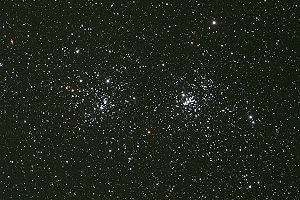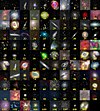h Persei

|
|
| h Persei on the right and Chi Persei on the left in the picture | |
| AladinLite | |
| Constellation | Perseus |
|
Position equinox : J2000.0 |
|
|---|---|
| Right ascension | 02 h 19 m |
| declination | + 57 ° 09 ′ |
| Appearance
|
|
| classification | I3r |
| Brightness (visual) | +5.3 mag |
| Brightness (B-band) | +5.74 mag |
| Angular expansion | 30 ′ |
| Redness ( excess color E (BV)) | 0.567 |
| Physical data
|
|
| Affiliation | Perseus OB1, Milky Way |
| Redshift | −0.000130 ± 0.000006 |
| Radial velocity | (−39 ± 2) km / s |
| distance | approx. 8300 ly (approx. 2500 pc ) |
| history | |
| Discovered by | Hipparchus |
| Discovery time | 130 BC Chr. |
| Catalog names | |
| NGC 869 • C 0215 + 569 • OCl 350 • Mel 13 • Cr 24 • Lund 73 • GC 512 • Raab 9 • h 207 • H VI 33 | |
h Persei (NGC 869) and Chi Persei (NGC 884) are two closely spaced, open star clusters in the constellation Perseus .
The apparent brightness is 5.3 mag with an angular extension of 30 '. With the naked eye, h Persei can be seen as a faint spot of nebula.
The property was built in 130 BC. Described by the Greek astronomer Hipparchus .
Stars (selection)
| Surname |
apparent brightness |
Spectral class |
Proper movement ( mas / a ) right ascension |
Proper movement ( mas / a ) declination |
Distance (Lj) |
|---|---|---|---|---|---|
| HD 14134 | 6.57 | B3 Ia | −0.64 | −1.29 | 8000 |
| HD 14143 | 6.70 | B3 I | −0.35 | −1.28 | 7600 |
| HD 14052 | 7.79 | B1 Ib | −0.41 | −1.19 | 7000 |
| V757 Persei | 7.83 | B0.7 I. | −0.04 | −0.99 | 11000 |
| HD 13969 | 8.02 | B0.5 I. | +0.74 | −2.28 | 7800 |
| BD + 56 ° 473 | 8.07 | B1 III / Ve | −0.39 | −1.15 | 8800 |
Remarks:
literature
- Rudolf Jung : h and χ Persei. Dissertation. University of Bonn. Dümmler, Berlin 1937.
Web links
Commons : NGC 869 - collection of images, videos, and audio files
- NGC 869 and NGC 884
- Double star clusters in Perseus - Astronomy Picture of the Day from January 3, 2009.
- Double star clusters in Perseus - Astronomy Picture of the Day of December 7, 2007.
- Spektrum.de : Amateur recordings [1] [2] [3]
